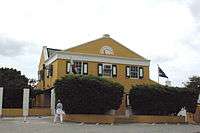Curaçao (liqueur)

| Type | Liqueur |
|---|---|
| Manufacturer | (various) |
| Country of origin | Curaçao |
| Introduced | 19th century |
| Alcohol by volume | 15–40% |
| Color | originally colorless, but often artificially colored blue and other colors |
| Flavor | laraha (bitter and sweet orange) |
Curaçao (/ˈkjʊərəsaʊ/ KEWR-ə-sow) is a liqueur flavored with the dried peel of the laraha citrus fruit, grown on the island of Curaçao.
A non-native plant similar to an orange, the laraha developed from the sweet Valencia orange transplanted by Spanish explorers. The nutrient-poor soil and arid climate of Curaçao proved unsuitable to Valencia cultivation, resulting in small, bitter fruit of the trees. Although the bitter flesh of the laraha is hardly edible, the peels are aromatic and flavorful, maintaining much of the essence of the Valencia orange.[1]
Curaçao liqueur was first developed and marketed by the Senior family in the 19th century.[2] To create the liqueur the laraha peel is dried, bringing out the sweetly fragranced oils. After soaking in a still with alcohol and water for several days, the peel is removed and other spices are added. The liqueur has an orange-like flavor with varying degrees of bitterness. It is naturally colorless, but is often given artificial coloring, most commonly blue or orange, which confers an exotic appearance to cocktails and other mixed drinks. Blue color is achieved by adding a food colorant, most often E133 Brilliant Blue.[3]
Some other liqueurs are also sold as Curaçaos with different flavors added, such as coffee, chocolate, and rum and raisin.
-

Landhuis Chobolobo, where the Genuine Curacao Liqueur is still being made today.
-

A glass of Blue Curaçao liqueur
See also
References
External links
| Wikimedia Commons has media related to Blue Curacao. |
- Curacao of Curacao Liqueur – Website of the original Curaçao Liqueur
| ||||||||||||||||||||||||||||||||||||||||||||||||||||||||||||||


